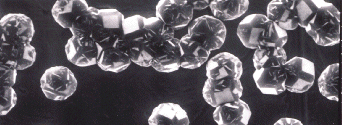Research
Nanomaterials

Nanomaterials are basically solids composed of (very small) particles of a size below 100 nm,
and they are of interest in chemistry since they possess properties quite distinct from normal bulk materials.
A famous example of this phenomena is the behaviour of gold nanoparticles - whereas bulk gold is quite an inert substance
, gold nanoparticles are much more reactive and indeed can be used as excellent catalysts for a range of reactions.
Nanomaterials already have important uses, in our everyday lives and also as advanced functional materials.
Examples of the former include the use of titania nanopowders as pigments in paints and suntan creams ;
examples of the latter include the uses of platinum nanoparticles as advanced (electro-) catalysts,
and the addition of nanoparticles to polymers to induce specific functionality such as biocidal properties.
The group is concerned with the chemical synthesis of new solid-state nanomaterials, to enable novel applications
in such areas as chemical sensors, biomaterials and bioelectronics, and catalysis, along with closely related studies on the surface
chemistry of materials. Apart from the fabrication of the materials, we also carry out detailed physical characterisation using a compre
hensive range of physical methods such as electron microscopy, atomic force microscopy, XRD, scanning electrochemical microscopy,
dynamic electrochemistry, Raman, Ir and nmr spectroscopies and XPS, and measure functional performance for particular applications.
The investigations raise intriguing academic challenges since achieving an understanding of the factors controlling chemical structure,
stability, and kinetics of nanomaterials and interfaces often requires very new concepts and methodologies.
Back to top
Green Nanomaterials
1. Nanomaterials for sustainable ("green") energy applicationsA future energy vision to reduce the emission of greenhouse gases is based on the use of hydrogen as a fuel source, which can be "burnt" to form water either in a conventional combustion process, or more likely via its use in fuel cells to produce electricity. For most of these latter types of application (eg. electric cars, laptops), a portable form of hydrogen is needed, for which
possibilities such as cryogenic or high-pressure storage of hydrogen are unattractive. We are studying chemical routes for the generation of "hydrogen on demand" which involve heterogeneous reactions at the interface between liquids and nanodisperse solids. A related project is the development of improved catalysts for use in fuel cells. At present these devices contain Pt nanoparticles which catalyse the fuel cell chemistry, and the cost of the Pt can be prohibitive. We are therefore engaged in the search for better catalysts, either by combining Pt with other elements, or using improved Pt nanoparticle synthesis methods.
Back to topDiamond Flims
2. Fabrication and applications of diamond films for chemical sensors Chemical sensors are devices which measure the composition of some gas or liquid phase medium , normally producing an electrical signal. An important area is biosensing - the measurement of biochemicals in living tissue - and we are currently engaged developing a range of biosensors, for chemicals such as neurotransmitters and glucose. The sensor design is of an electrochemical nature, and normally involves the modification of electrode surfaces with enzymes and catalytic particles to produce a selective chemical reaction with the target analyte. This produces a chemical which can be oxidised by the electrode to produce an electrical signal current.
Self-assembly Nanomaterials
3. Self-assembly of nanomaterials
Nanostructured materials are often assembled into larger structures
by a process known as self-assembly, whereby chemical forces drive the
arrangement of the nanoparticles of interest into, a process also
widely used in nature (e.g. opalescence materials in butterlfly wings!)
We are particularly interested in the use of self-assembly for the fabrication of nanostructured coatings based on novel forms of carbon such as nanodiamond, carbon nanotubes and graphene, and studying the properties of these structures such as their ability to impart biocidal action or promote cell growth on the surfaces in question.
Back to top